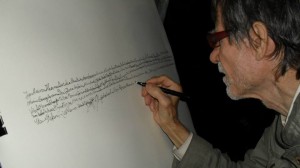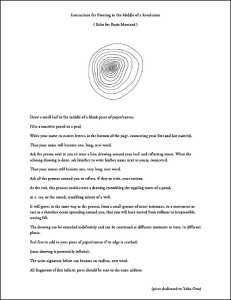‘Echo for Rosia Montana’ – Participatory Art Project
The project ‘Echo for Rosia Montana’ is a participatory art piece created in various cities of the world by hundreds of people (protesters, activists or participants in solidarity). The collective art piece was created during the Rosia Montana environmental protests in 2013 (the Romanian Autumn ). Since September 1st 2013, Romanians around the world had been protesting against a very destructive mining project: according to Gabriel Resources Ltd., the company proposing it, four mountains would be blown up in order to extract the massive gold deposits in Rosia Montana, creating one of the largest open-cast mining projects in the world. There were great risks of an ecological catastrophe– the mountaintops removed would create a 400m deep crater, visible from the moon, leaving behind a vast cyanide lake (185m deep). The extraction process would be using , every year, 13 times more cyanide than all the mining industries in the rest of Europe put together, and the toxic spillage could potentially cause incalculable environmental damage both to Romania and the neighbouring countries, polluting rivers, the Danube and the Black Sea. The protests started when the Romanian government announced its intention to change the law in order to allow the forced expropriation of the local inhabitants in Rosia Montana for commencing the mining project.
The conceptual instructions for the artwork were given to the activists involved in the protests, to use as they desired. Most of the performances and the collection of the artworks were organised in collaboration with a team of activists and volunteers in London, part of the group ESC (Environmental and Social Change) , but there were many other protesting groups that spontaneously took part in the project. Thus, the events were organised worldwide through a network of activists and protesters that wished to take part and to include this artistic intervention in their local protests. The pieces created in various locations were sent by post and reunited in London, where they were exhibited for the first time in London at the Romanian Cultural Centre, on the 6th of February 2015. Hundreds of participants in over 20 cities around the world took part in the creation of this collective drawing. Among the contributors, there were also the academia and ‘La Maison Romaine’ in Paris, the Romanian architect Serban Cantacuzino and the Executive Director of Greenpeace International, Kumi Naidoo. ( Documenting images can be seen at this link )
The collaged canvases contain countless unique acts of reflection. The event’s score was the following: one by one, lines were drawn around a linearly-sketched leaf in the middle of a paper/canvas, each reflecting as closely as possible the vibrations of the line drawn by the person before. The names of the participating artists were signed below, linked into one word (the poetic text of the artwork can be seen at this link ). Additionally, a certificate of authenticity was signed by each participant, stating the collective ownership of the art piece and the interdiction to sell it without the unanimous consent of all contributing artists. The gesture hints to the situation of the natural and cultural heritage at Rosia Montana (and elsewhere in the world) and questions all commercial enterprises based on very destructive, unjustified methods (‘the cultural and natural heritage of any country belongs to all humanity, not to any temporary political/social/economic structure’). It hints as well to the art market procedures (the Certificate of authenticity being usually used when purchasing an art piece) and raises questions of collective ownership.
The decision to use a leaf as an initial drawing was taken after conversations with the participating activists – as they wished to reflect the symbol of the Rosia Montana protests.
The artistic intention was to create a project based on open, fluid, spontaneous collaboration, and which questions conventions of artistic authorship, ownership, property, but first and foremost which would release immense creative energy and involve people coming from every walk of life, thus challenging the separate role of the specialized artist in our current social structure. The project is concerned with the communication and relationships it creates just as much as with its formal outcome and it is intended as a liberating, empowering symbolic action. As the collective drawings were created during protests, it also became a visual recording of the intensity and energy of those moments. An artistic background in gestualist and neo-expressionist painting can be traced in the piece’s focus on the personal, meditative, performative drawing process involved. The piece thus references themes of unique individual expression, confronting them with those of collective action, forms of communication, and transmitted energy. The artwork was also intended as an artistic dialogue, and dedicated to Yoko Ono, whose instructional paintings and activism inspired it.
Another important issue was that of actualising it within authentic social contexts – the event in which it was presented becoming a natural continuation of the piece. Thus, the ‘Echo for Rosia Montana’ installation surrounded the speakers and the guests and a vibrant cross-reference occurred, an art/life transfer which is explored by the artwork. The panel discussion and the documentary screenings were echoed in the content of the piece, the entire event being in fact created in a close collaboration with the ESC activists and the Romanian Cultural Centre. One of the guest speakers was Dr. Mike Dawson, director at CgMs and co-author of the report on Rosia Montana about the extraordinary importance of the area’s archaeological and historical heritage. He was joined by Richard Solly, Coordinator of the London Mining Network . They presented their research on the heritage case at Rosia Montana and the arguments for its inclusion amongst the UNESCO World Heritage sites.
Among the documentaries screened was ‘Romanian Autumn’ directed by Matei Budes and several other short films presenting the protests and the local community at Rosia Montana.
The installation was site-specific and, in this case, it was moulded on the architectural structure of the building but any further installations will respond to the conditions of each space and additional structures will be constructed if necessary.
The art piece ‘Echo for Rosia Montana’ is an ‘opera aperta,’ an open form with its own, fluid growth.
‘Echo for Rosia Montana’ at the Romanian Cultural Centre –installation view
‘Echo for Rosia Montana’ at the Romanian Cultural Centre and the panel discussion on the Rosia Montana Day with Dr. Mike Dawson, director at CgMs & co-author of the report on Rosia Montana, Richard Solly, Coordinator of the London Mining Network and Anca Giurgiu (journalist, ESC member)
‘Echo for Rosia Montana’ at the Romanian Cultural Centre –installation view
‘Echo for Rosia Montana’ at the Romanian Cultural Centre –installation view during the documentary screenings
Selection of images with the creation of the artwork during protests, shown in the exhibition:
Selection of images with the creation of the ‘Echo for Rosia Montana’ in Bucharest during the protests in November 2013 (photos taken by participating activists and shared on social media)
Selection of images with the creation of ‘Echo for Rosia Montana’ during the protests in November 2013 (photos taken by participating activists and shared on social media) – locations: Bucharest (Romania), Hanover (Germany), Montreal (Canada), Cluj (Romania), London (United Kingdom)
Selection of images with the creation of ‘Echo for Rosia Montana’ during the protests in November 2013 (photos taken by activists and shared on social media) – locations: Oxford (United Kingdom), London (United Kingdom)- at Romanian Film Festival, Redmont Community Centre& National Gallery
Images with the creation of ‘Echo for Rosia Montana’ during the protests in November 2013: Kumi Naidoo, the Executive Director of Greenpeace International participated as well, symbolically, at the protest in front of the National Gallery, in London ). Besides the protesters, a lot of passers-by participated spontaneously, in solidarity.
Selected images with the creation of ‘Echo for Rosia Montana’ during the protests in November 2013 in Cluj and Bucharest, Romania – (photos taken by activists and shared on social media)
Sketch for the site-specific installation
Instructional text of the artwork























